(For the complete list of popes from Blue Guide Rome see here.)
(And for the abdication of popes, see Pope Benedict: an unorthodox farewell »)
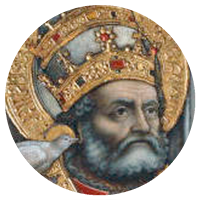
St Gregory I (‘the Great’; 590-604)
The son of a wealthy family in Rome, with two former popes in his ancestry, Gregory took a life of monastic austerity after periods of time studying law and as prefect of Rome. This combination proved invaluable to the emperor and people of Rome, resulting in Gregory being forcibly removed from cloister life to be elected Pope. Despite his reservations, he was an energetic and practical pope, becoming heavily involved in the civil ruling of Italy, and defining Papal supremacy in both the east and western empires.
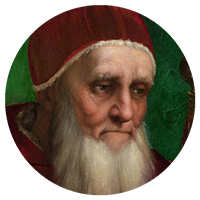
Julius II (Giuliano della Rovere; 1503-13)
Born to a humble family in 1443, the ruthless and energetic Giuliano della Rovere has gone down in history as the warrior pope, a man who led his armies into battle dressed in full armour, and who was satirized by Erasmus as the pontiff whom St Peter balked at admitting to Paradise. When the grandiose funerary monument planned for him by Michelangelo came to nothing, Julius was buried simply beneath the pavement of St Peter’s.
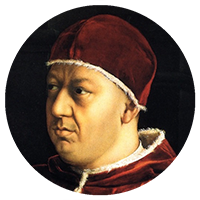
Leo X (Giovanni de’ Medici; 1513-21)
The second son of Lorenzo the Magnificent, Giovanni de’ Medici was created cardinal when only thirteen. The celebrated portrait by Raphael (of whom Leo was an enthusiastic patron) shows him to have been rather corpulent. He perspired a good deal and during ecclesiastical functions was always wiping his face and hands, to the distress of bystanders. Leo was a celebrated bon viveur and passionate hunter, said to have exclaimed ‘Since God has granted us the Papacy, let us enjoy it!’. His bull Exsurge Domine of 1520 condemned 41 errors of Martin Luther. His tomb is in Santa Maria sopra Minerva.
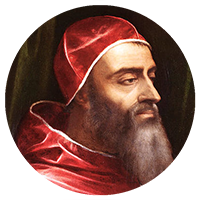
Clement VII (Giulio de’ Medici; 1523-34)
The bastard nephew of Lorenzo the Magnificent, Giulio de’ Medici was declared legitimate and created cardinal in 1513. He had dark brown eyes, the left one squinting. According to Benvenuto Cellini he had excellent taste-the beautiful but faded portrait by Sebastiano del Piombo (Capodimonte, Naples) makes him look vain and supercilious. Clement’s bitter relations with the Emperor Charles V led to the disastrous Sack of Rome in 1527. Trapped for seven months in Castel Sant’Angelo, he grew a beard as a sign of mourning. He refused to allow Henry VIII to divorce Catherine of Aragon. He is buried in Santa Maria sopra Minerva.
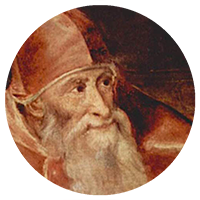
Paul III (Alessandro Farnese; 1534-49)
As cardinal, Alessandro Farnese fathered four children, but he put away his mistress in 1514. His secular interests were not entirely abandoned, however. He loved masked balls, fireworks, clowns and dwarfs, and in 1536 he revived the carnival, when enormous floats were dragged through the streets of Rome by teams of buffalo. Yet he was a great reformer, and as well as his human children he fathered a number of religious orders, most importantly the Jesuits, in 1540. Paul also established the Congregation of the Roman Inquisition, to extirpate heresy. When he was elected, he claimed he had waited 30 years for Michelangelo-and promptly commissioned the Last Judgement and the new layout of the Campidoglio. He is buried in St Peter’s in a beautiful tomb by Guglielmo della Porta.
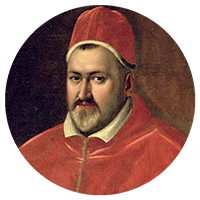
Paul V (Camillo Borghese; 1605-21)
From a Sienese family, but a self-proclaimed proud Roman, Paul V amassed great power and fortune for himself (and his relatives) whilst pope, and oversaw a number of substantial projects in Rome: the completion of St Peter’s, the rebuilding of a Trajan aqueduct which supplied fresh water to fountains in the city, and the enrichment of the Vatican library. His nephew, Cardinal Scipione Borghese, was one of the great art collectors of the time. Paul is buried in the Borghese chapel in Santa Maria Maggiore.
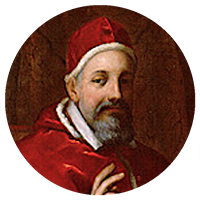
Urban VIII (Maffeo Barberini; 1623-44)
Authoritarian, highly conscious of his own position, and a shameless nepotist, Urban was also learned and artistic. He wrote Latin verses (and indeed spoilt many hymns in the Breviary by rewriting them). Though an unpopular pope (there was unseemly rejoicing when he died), he gave Rome the art and architecture of Bernini, the young sculptor whom he made architect of the new St Peter’s. The basilica was consecrated in 1626. Urban lies buried there, commemorated by a funeral monument designed by his brilliant protégé.
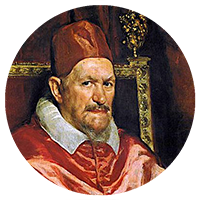
Innocent X (Giovan Battista Pamphilj; 1644-55)
Innocent was elected in 1644, after a stormy conclave (he was opposed by France), and consecrated on 4th October at a particularly splendid ceremony, when for the first time the sanpietrini lit up the dome of the basilica with flaming torches. His ugliness was noted by contemporaries, and Velázquez’s famous portrait in the Palazzo Doria Pamphilj – which inspired several modern versions by Francis Bacon – has caught his disturbing, implacable gaze. His life was blameless, but he was irresolute and suspicious. Innocent died in January 1655 after a long agony; no one wanted to pay for his burial. Later a funerary monument was set up in the church of Sant’Agnese, which has a façade by his favourite architect, Borromini.
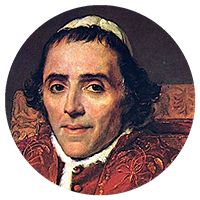
Pius VII (Luigi Barnaba Chiaramonti; 1800-23)
Elected in March 1800, Pius was constrained by political and military events to sign a concordat with Bonaparte in 1801. In 1804 he went to Paris to officiate at the emperor’s coronation; he was rudely treated, and Napoleon placed the crown on his own head. In 1809 Pius was arrested by the French and interned. In 1814, after Bonaparte’s fall, he returned to Rome amidst general rejoicing. Pius was magnanimous towards Napoleon’s family. He died in 1823, after falling and breaking a leg. His funerary monument in St Peter’s is by (the Protestant) Bertel Thorvaldsen.
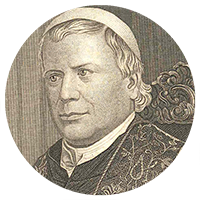
Pius IX (Giovanni Maria Mastai-Ferretti; 1846-78)
Pius was politically maladroit, and to many his name is a byword for intransigence and arch-conservatism. Garibaldi despised him and named his horse ‘Papa Mastai’; in Italian his regnal number (Pio Nono) sounds like a double negative, as though he were always saying ‘No, no’ to the radical reforms that were proposed to him-unsurprising, perhaps, since the radicals wanted his territories. Nationalist armies seized the Papal States in 1860 and Rome in 1870, confining papal authority to the Vatican. Pius was the last pope to hold temporal power. On the ecclesiastical level he was a very great pope, and even his enemies acknowledged his charm. In 1856 he defined the dogma of the Immaculate Conception; in 1870 he proclaimed the dogma of Papal Infallibility. After the longest reign in papal history he died in 1878, and lies buried in a simple tomb in San Lorenzo fuori le Mura.
From text written by Mark Roberts from Blue Guide Rome.
More Roman history:
Pilgrim’s Rome
Rome: 20 key history dates
Rome: A dictator and handful of emperors
Rome: Complete list of popes






